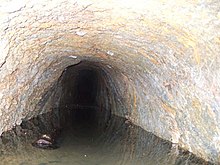Caspari colliery
| Caspari Pit | |||
|---|---|---|---|
| General information about the mine | |||
| Rare minerals | Stibnite , boulangerite , jamesonite | ||
| Information about the mining company | |||
| Start of operation | 1727 | ||
| End of operation | 1892 | ||
| Funded raw materials | |||
| Degradation of | antimony | ||
| Geographical location | |||
| Coordinates | 51 ° 24 '59.5 " N , 8 ° 6' 23" E | ||
|
|||
| local community | Arnsberg | ||
| District ( NUTS3 ) | Arnsberg | ||
| country | State of North Rhine-Westphalia | ||
| Country | Germany | ||
The Caspari colliery was an ore mine in Uentrop near Arnsberg . Mainly antimony ore was mined . This made it one of the few economically exploited deposits of this mineral in Europe.
History and Development
| year | Funding in quintals |
|---|---|
| 1842 | 309 |
| 1846 | 63 |
| 1861 | 447 |
| 1862 | 1556 |
| 1863 | 2120 |
| 1864 | 1980 |
| 1865 | 2041 |
| 1866 | 1593 |
| 1867 | 885 |
| 1871 | 164 |
| 1877 | 433 |
| 1879 | 555 |
| 1880 | 1086 |
There are indications in the form of pings , cuts and spoil heaps that there was quite intensive mining at this point early on . Details are not known. The underground mining took place on the Silberberg and in the Silbersiepen. The first reports about the colliery are from 1727. In 1732, the mining expert Brückmann (1697–1753), who came from Braunschweig, described the mountain treasures of all four continents: “ Arnsberg, a patch, has a lot of iron stone, in which you can find genuine gold. “The system was in operation at the time, but fell into disrepair in the years that followed. Only between 1786 and 1788 was operations resumed. The company was run in the form of a union . The trades originally aimed at the extraction of galena. When the mineralogist and mining expert Anton Wilhelm Stephan Arndts realized that mining was not worthwhile, the mine was closed again. Arndts published a treatise on the colliery in 1834. In addition to the geological analysis, he reported that at the beginning of the 19th century two attempts were made to put the mine back into operation, but these attempts soon failed.
Regular mining began in 1825. The actual initiator was Johann Caspar Rumpe from Altena . He was there mayor and entrepreneur in metal manufacturing. The Caspari colliery was supposed to supply the antimony necessary for production. The name of the colliery goes back to the middle name Rumpes. In addition to the mining of antimony, marble should also be extracted. The deposits turned out to be insufficiently productive. By 1858 the limit of the mining field Zeche Caspari I, which was awarded in 1824/24 , had been reached. A connection field Caspari-Zeche II was awarded in 1861. Later the field was expanded again. The two fields I and II were consolidated (that is, united) in 1881. At that time the area covered an area of 4,300,000 m².
A total of twelve tunnels were created during its existence in the 19th century . These were 1.80 m high and between 60 cm above and 91 cm below wide. The so-called Glückaufstollen and the oldest gallery (Caspari-Stollen) were particularly productive. This was 190 m long. Until 1874 the mined ores were transported to Altena. Only then was a melting plant set up in Uentrop. The delivery rate was very different. But the peak was in the 1860s. The collapse began in the 1880s, before the mine was closed in 1892 due to unprofitability and the exhaustion of the ore deposits.
Some old tunnels can still be found today. After the flood in August 2007, a buried tunnel entrance was cleared again, so that the old support beams are partially visible again. The water that runs out of the tunnel feeds the Mühlmecke stream.
Another tunnel is still well preserved, but it is not accessible and is under water. It was driven forward without any further cross aisles and ends after approx. 100 m.
List of studs
- Glückaufstollen
- Caspari tunnel (190 m long)
- Wilhelm tunnel
- Friedrich Stollen
- Maria-Stollen (started in 1877)
- Daniel tunnel (today water extraction)
- Auditor's tunnel
- Mariahülf tunnel
- Julius tunnel
- Pond tunnel
- Northern excavation tunnel
- Middle excavation tunnel
- Neuer Schurfstollen
- Southern mining tunnel
See also
Individual evidence
- ^ Winfried Reininghaus / Reinhard Köhne: Mining, smelting and hammer works in the Duchy of Westphalia in the Middle Ages and the early modern period. Münster, 2008 p. 191
- ↑ Casparizeche in the Mineralienatlas
literature
- Heinz Pardun: The Caspari colliery in the Uentrop district near Arnsberg. In: 800 years of Uentrop. A book about the history of the village and the Mark Uentrop . Arnsberg 2007, pp. 106-112
- Anton Wilhelm Friedrich Arndts: About mining on the spit shine on the Silberberge not far from Arnsberg in the Duchy of Westphalia . Arnsberg, 1834


